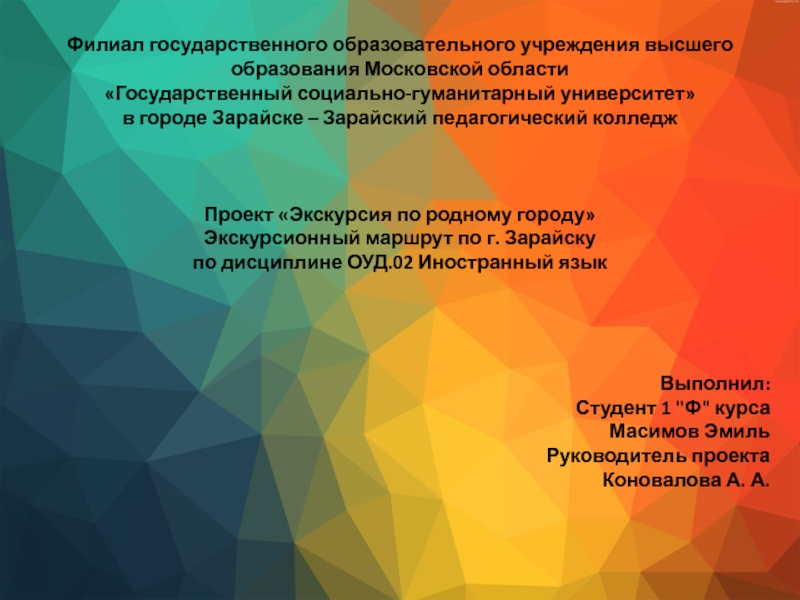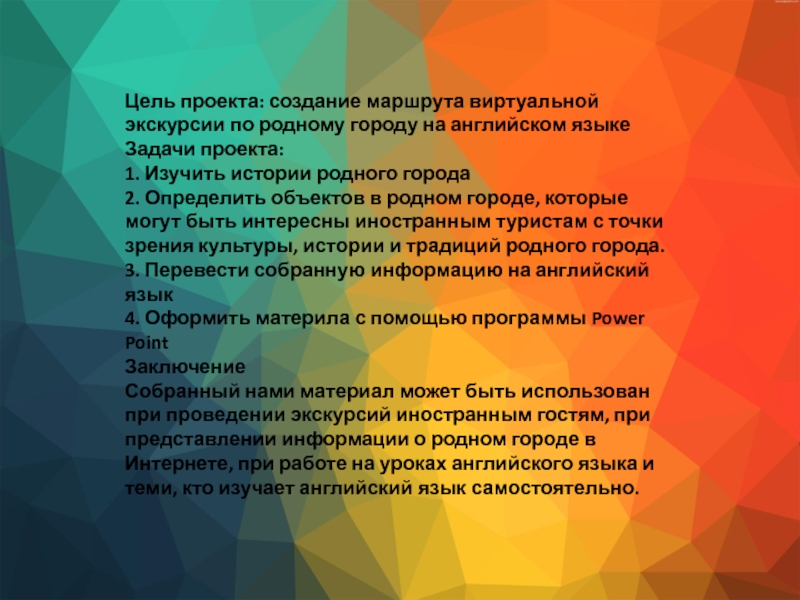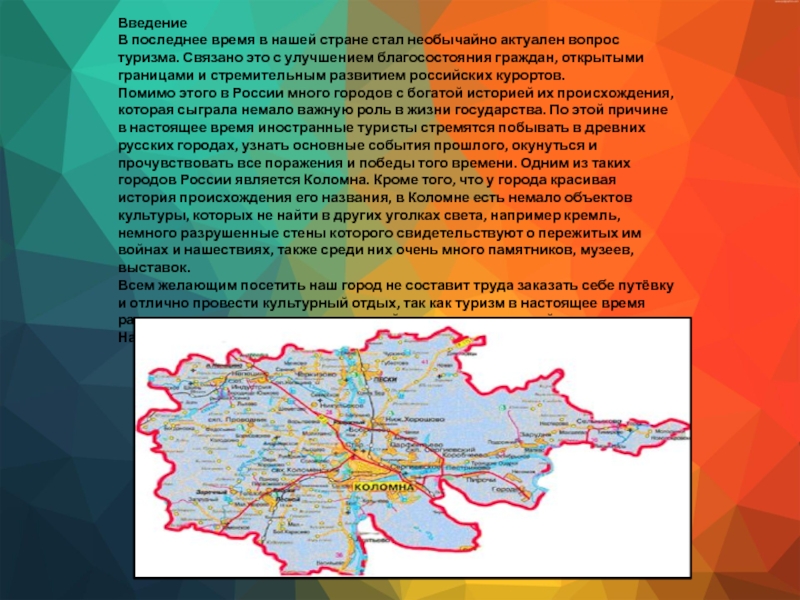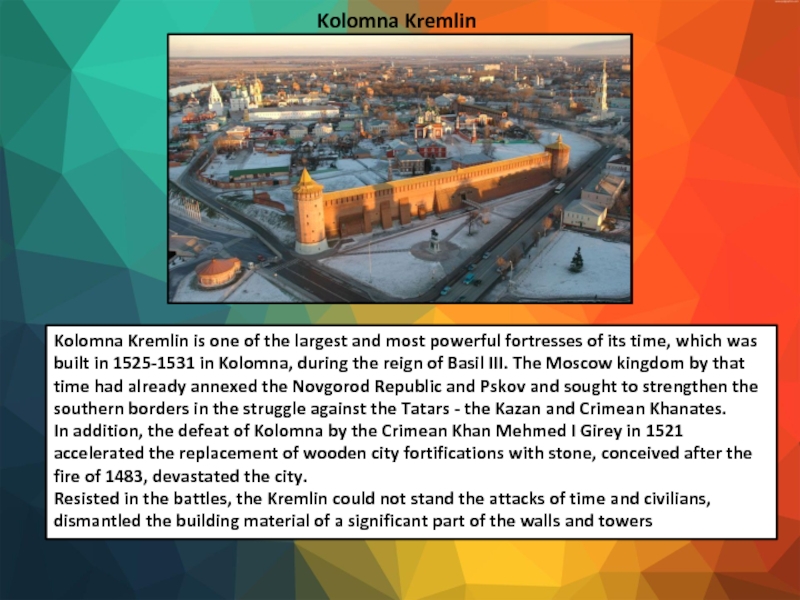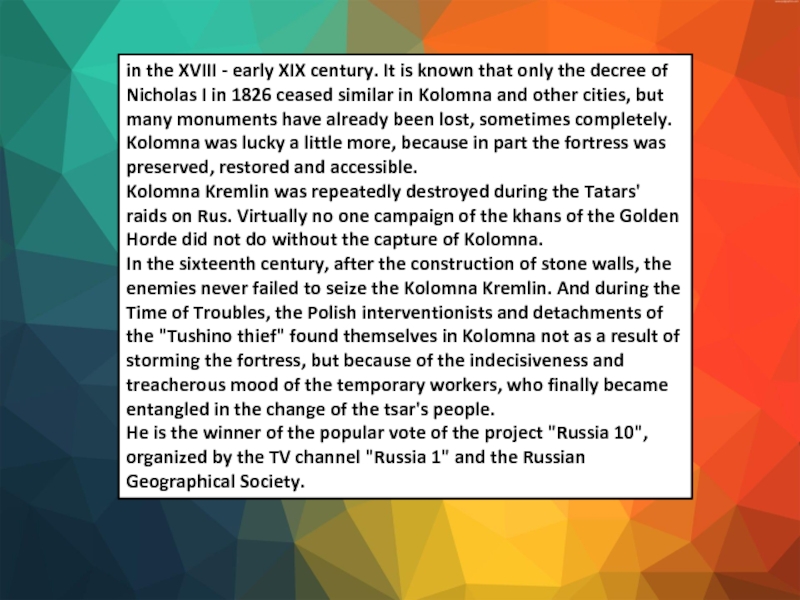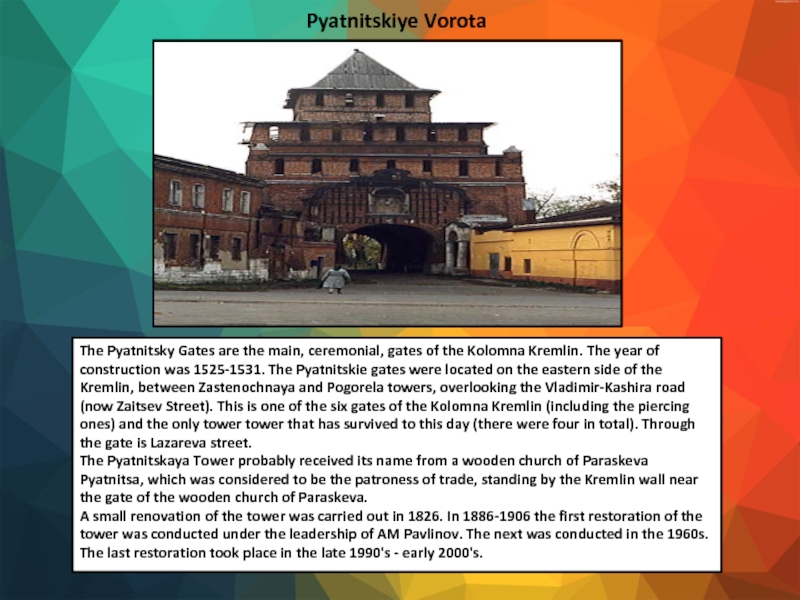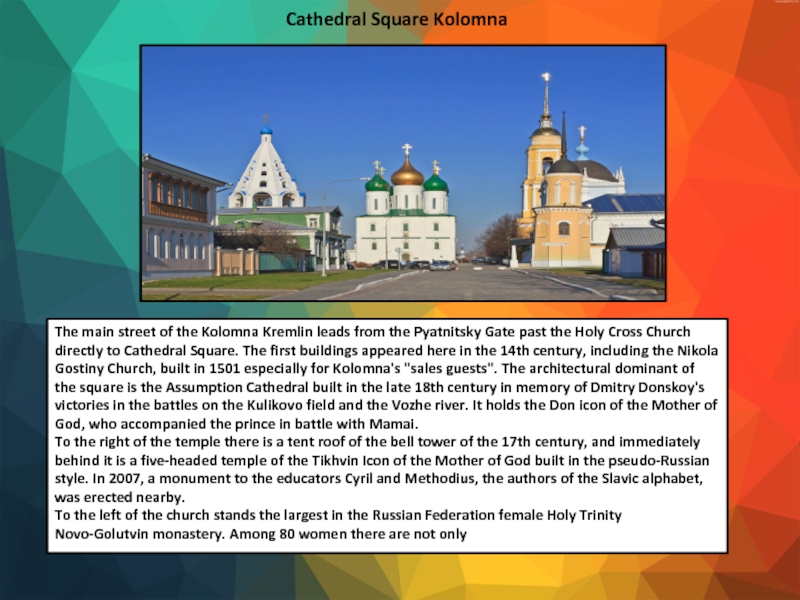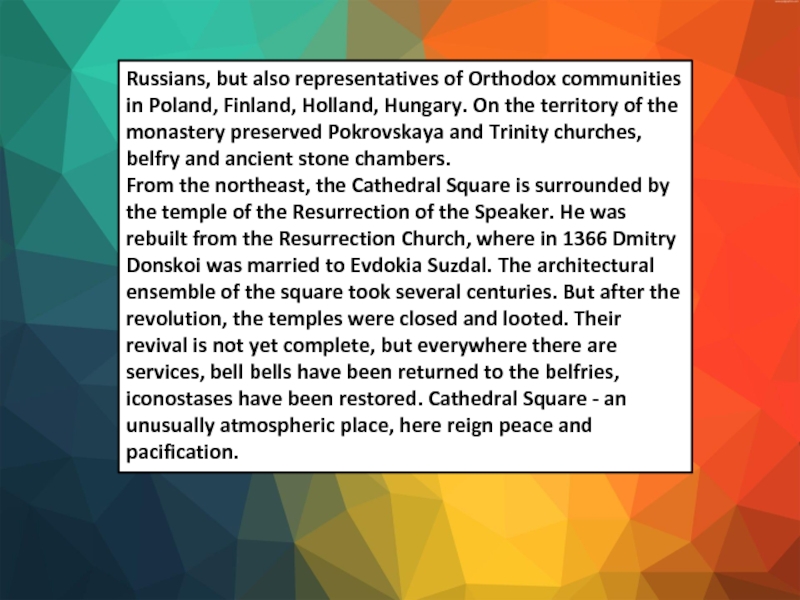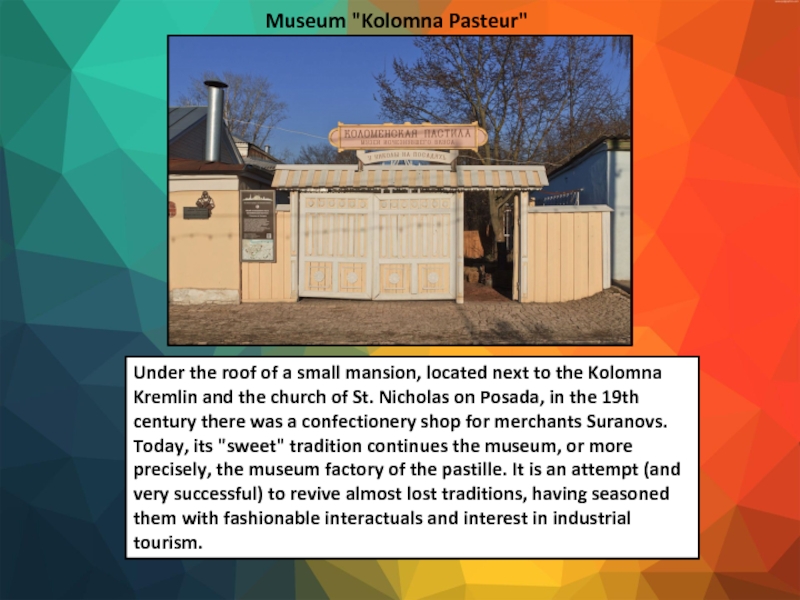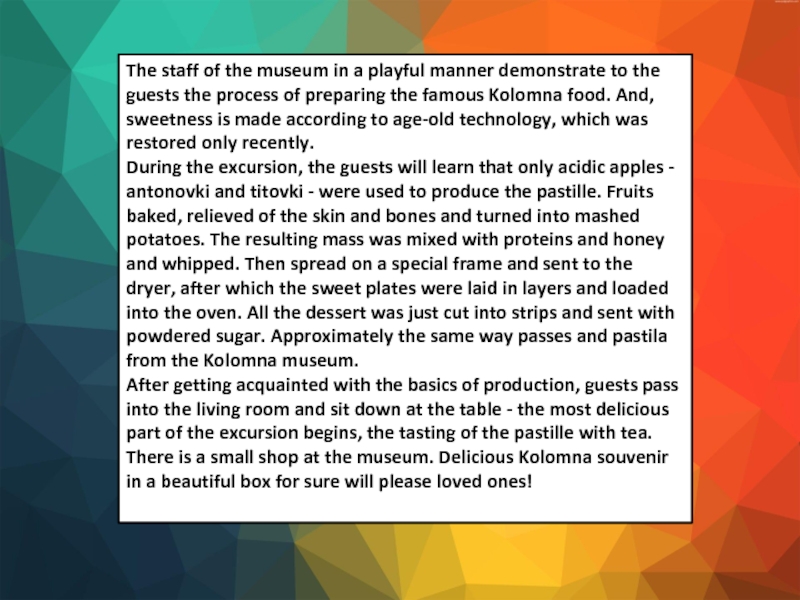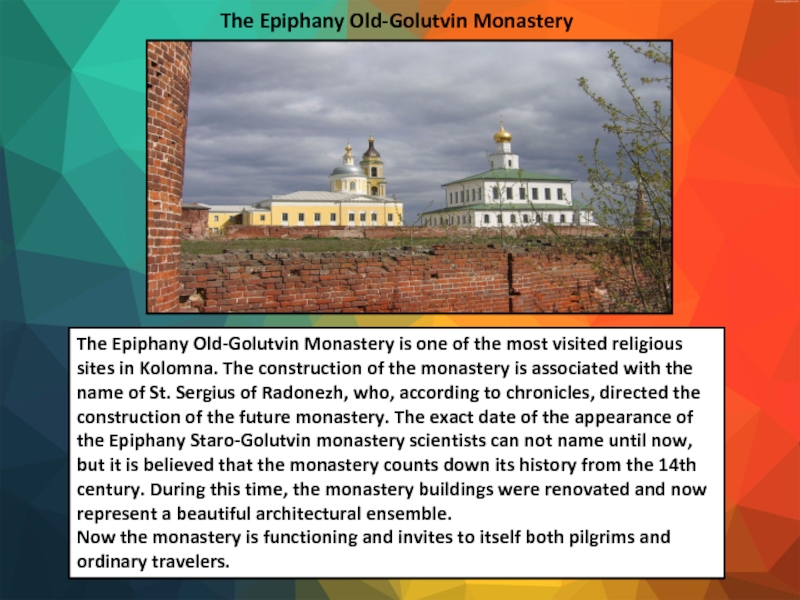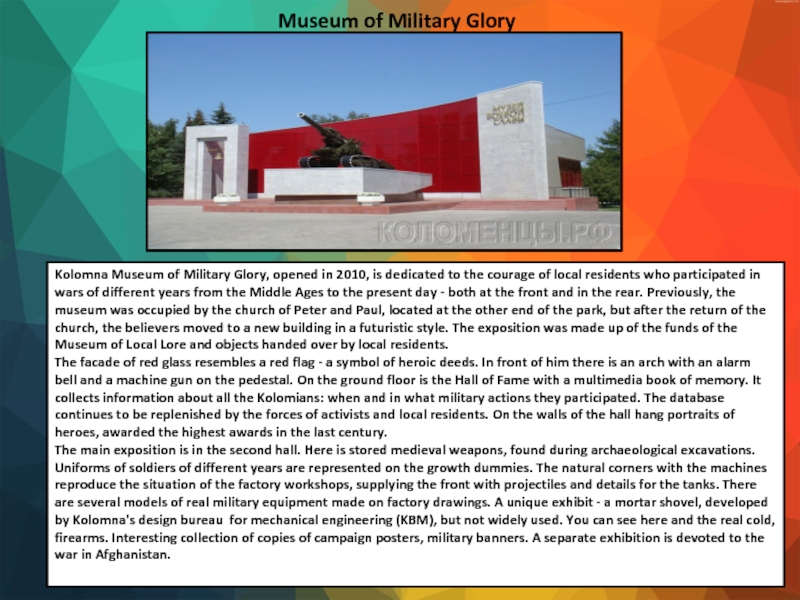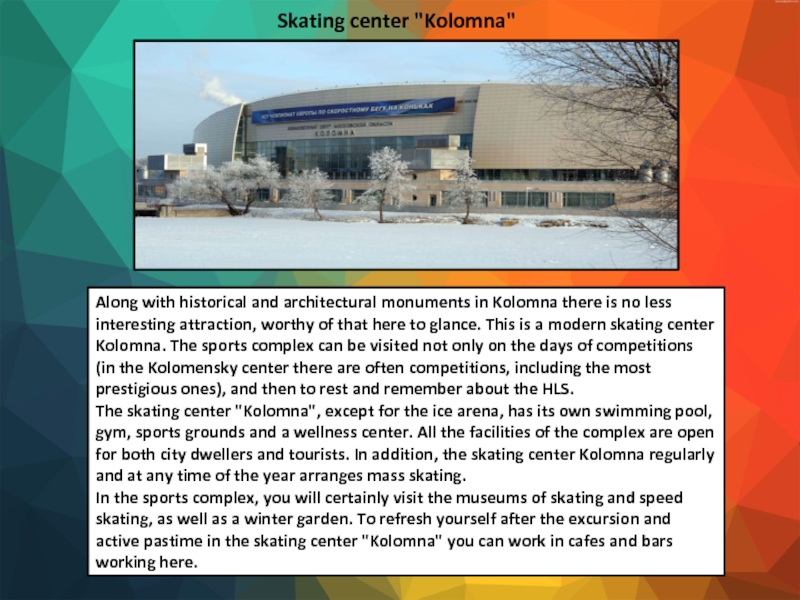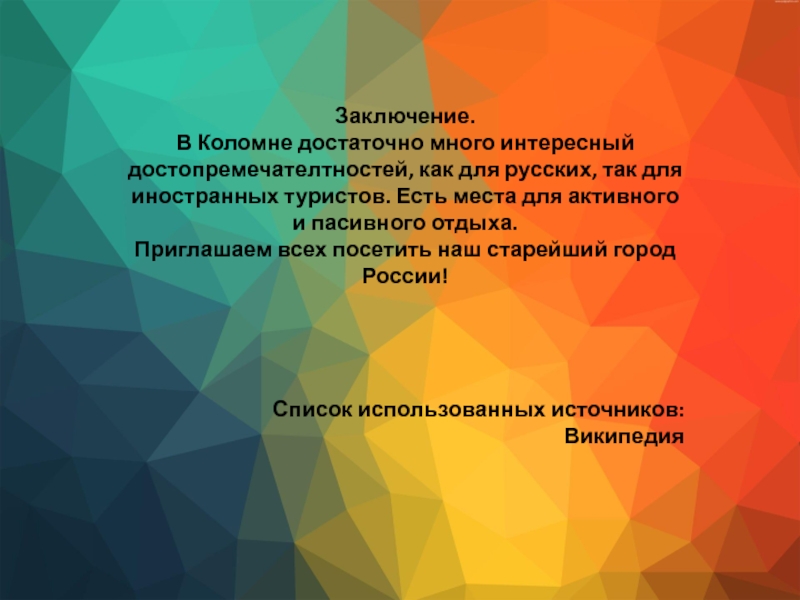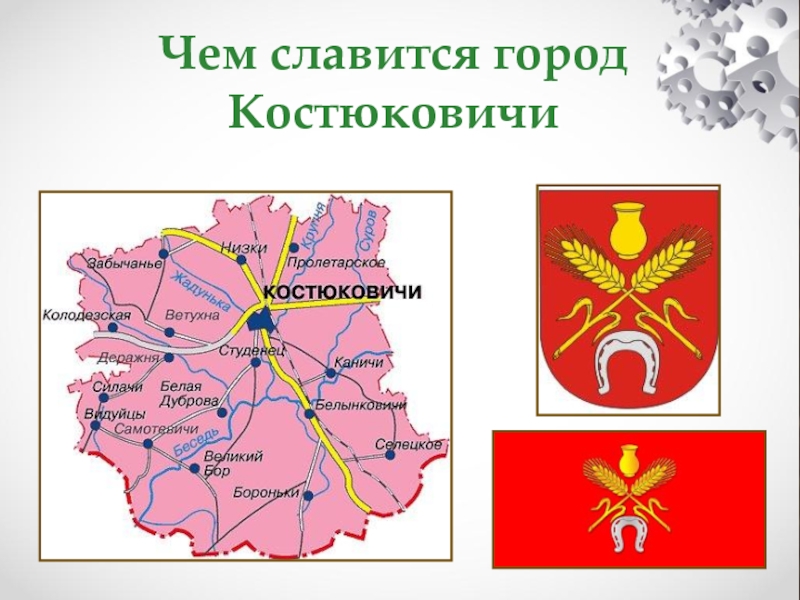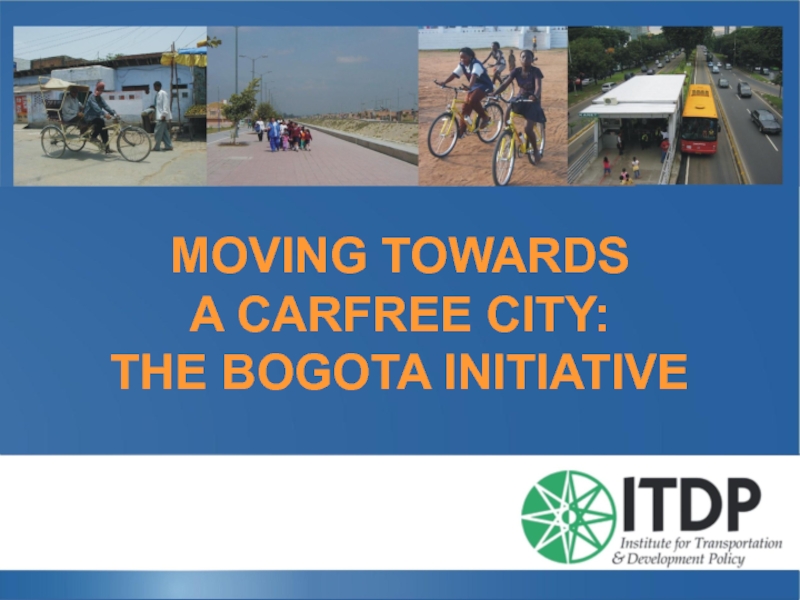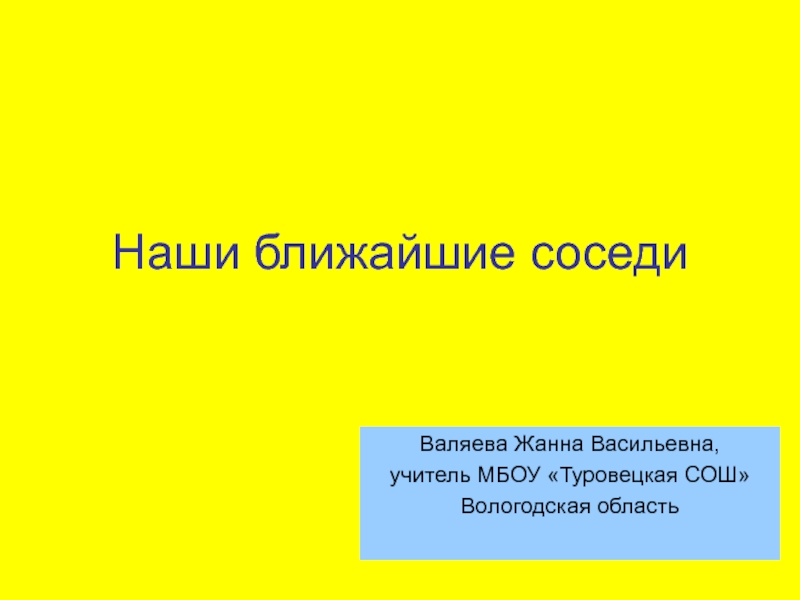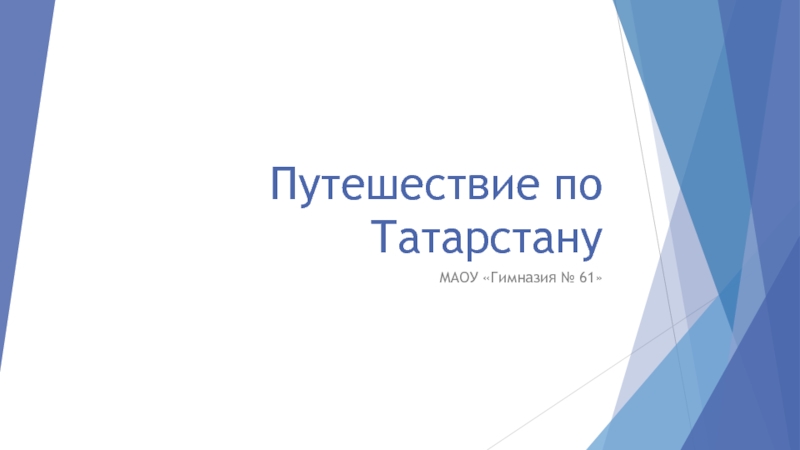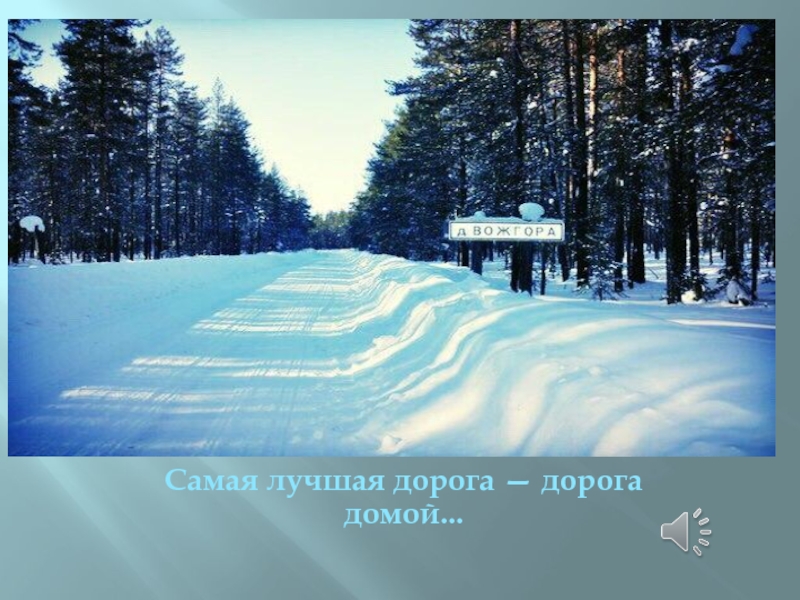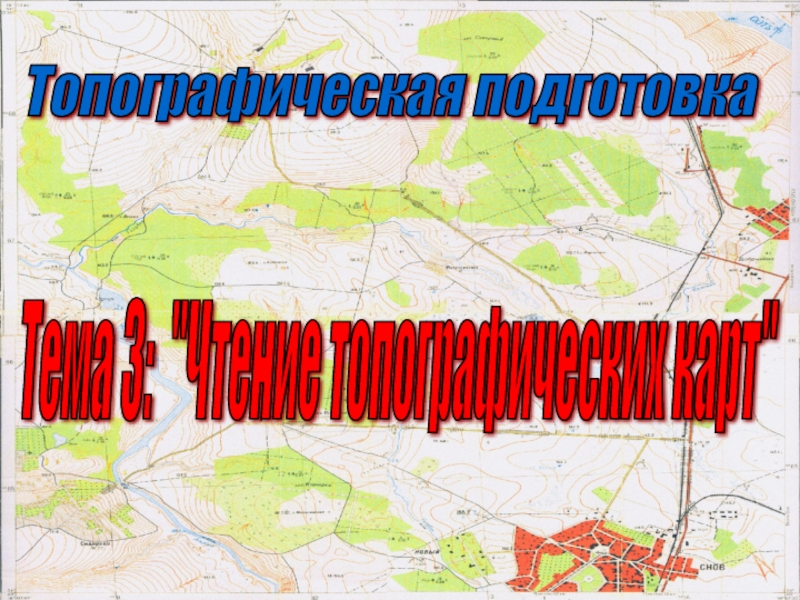Зарайске – Зарайский педагогический колледж
Проект «Экскурсия по родному городу»
Экскурсионный маршрут по г. Зарайску
по дисциплине ОУД.02 Иностранный язык
Выполнил:
Студент 1 "Ф" курса
Масимов Эмиль
Руководитель проекта
Коновалова А. А.
- Главная
- Разное
- Дизайн
- Бизнес и предпринимательство
- Аналитика
- Образование
- Развлечения
- Красота и здоровье
- Финансы
- Государство
- Путешествия
- Спорт
- Недвижимость
- Армия
- Графика
- Культурология
- Еда и кулинария
- Лингвистика
- Английский язык
- Астрономия
- Алгебра
- Биология
- География
- Детские презентации
- Информатика
- История
- Литература
- Маркетинг
- Математика
- Медицина
- Менеджмент
- Музыка
- МХК
- Немецкий язык
- ОБЖ
- Обществознание
- Окружающий мир
- Педагогика
- Русский язык
- Технология
- Физика
- Философия
- Химия
- Шаблоны, картинки для презентаций
- Экология
- Экономика
- Юриспруденция
Проект Экскурсия по родному городу. Экскурсионный маршрут по г. Зарайску презентация
Содержание
- 1. Проект Экскурсия по родному городу. Экскурсионный маршрут по г. Зарайску
- 2. Цель проекта: создание маршрута виртуальной экскурсии
- 3. Введение В последнее время в нашей стране
- 4. Kolomna Kremlin Kolomna Kremlin is one of
- 5. in the XVIII - early XIX century.
- 6. Pyatnitskiye Vorota The Pyatnitsky Gates
- 7. Cathedral Square Kolomna The main
- 8. Russians, but also representatives of Orthodox communities
- 9. Under the roof of a small mansion,
- 10. The staff of the museum in a
- 11. The Epiphany Old-Golutvin Monastery The Epiphany
- 12. Museum of Military Glory Kolomna Museum
- 13. Skating center "Kolomna" Along with historical
- 14. Заключение. В Коломне достаточно много интересный достопремечателтностей,
Слайд 1Филиал государственного образовательного учреждения высшего образования Московской области
«Государственный социально-гуманитарный университет»
в городе
Слайд 2
Цель проекта: создание маршрута виртуальной экскурсии по родному городу на английском
языке
Задачи проекта:
1. Изучить истории родного города
2. Определить объектов в родном городе, которые могут быть интересны иностранным туристам с точки зрения культуры, истории и традиций родного города.
3. Перевести собранную информацию на английский язык
4. Оформить материла с помощью программы Power Point
Заключение
Собранный нами материал может быть использован при проведении экскурсий иностранным гостям, при представлении информации о родном городе в Интернете, при работе на уроках английского языка и теми, кто изучает английский язык самостоятельно.
Задачи проекта:
1. Изучить истории родного города
2. Определить объектов в родном городе, которые могут быть интересны иностранным туристам с точки зрения культуры, истории и традиций родного города.
3. Перевести собранную информацию на английский язык
4. Оформить материла с помощью программы Power Point
Заключение
Собранный нами материал может быть использован при проведении экскурсий иностранным гостям, при представлении информации о родном городе в Интернете, при работе на уроках английского языка и теми, кто изучает английский язык самостоятельно.
Слайд 3Введение
В последнее время в нашей стране стал необычайно актуален вопрос туризма.
Связано это с улучшением благосостояния граждан, открытыми границами и стремительным развитием российских курортов.
Помимо этого в России много городов с богатой историей их происхождения, которая сыграла немало важную роль в жизни государства. По этой причине в настоящее время иностранные туристы стремятся побывать в древних русских городах, узнать основные события прошлого, окунуться и прочувствовать все поражения и победы того времени. Одним из таких городов России является Коломна. Кроме того, что у города красивая история происхождения его названия, в Коломне есть немало объектов культуры, которых не найти в других уголках света, например кремль, немного разрушенные стены которого свидетельствуют о пережитых им войнах и нашествиях, также среди них очень много памятников, музеев, выставок.
Всем желающим посетить наш город не составит труда заказать себе путёвку и отлично провести культурный отдых, так как туризм в настоящее время развит очень хорошо и является одной из ведущих отраслей экономики.
Наша работа направлена на изучение города Коломна!
Помимо этого в России много городов с богатой историей их происхождения, которая сыграла немало важную роль в жизни государства. По этой причине в настоящее время иностранные туристы стремятся побывать в древних русских городах, узнать основные события прошлого, окунуться и прочувствовать все поражения и победы того времени. Одним из таких городов России является Коломна. Кроме того, что у города красивая история происхождения его названия, в Коломне есть немало объектов культуры, которых не найти в других уголках света, например кремль, немного разрушенные стены которого свидетельствуют о пережитых им войнах и нашествиях, также среди них очень много памятников, музеев, выставок.
Всем желающим посетить наш город не составит труда заказать себе путёвку и отлично провести культурный отдых, так как туризм в настоящее время развит очень хорошо и является одной из ведущих отраслей экономики.
Наша работа направлена на изучение города Коломна!
Слайд 4Kolomna Kremlin
Kolomna Kremlin is one of the largest and most powerful
fortresses of its time, which was built in 1525-1531 in Kolomna, during the reign of Basil III. The Moscow kingdom by that time had already annexed the Novgorod Republic and Pskov and sought to strengthen the southern borders in the struggle against the Tatars - the Kazan and Crimean Khanates.
In addition, the defeat of Kolomna by the Crimean Khan Mehmed I Girey in 1521 accelerated the replacement of wooden city fortifications with stone, conceived after the fire of 1483, devastated the city.
Resisted in the battles, the Kremlin could not stand the attacks of time and civilians, dismantled the building material of a significant part of the walls and towers
In addition, the defeat of Kolomna by the Crimean Khan Mehmed I Girey in 1521 accelerated the replacement of wooden city fortifications with stone, conceived after the fire of 1483, devastated the city.
Resisted in the battles, the Kremlin could not stand the attacks of time and civilians, dismantled the building material of a significant part of the walls and towers
Слайд 5in the XVIII - early XIX century. It is known that
only the decree of Nicholas I in 1826 ceased similar in Kolomna and other cities, but many monuments have already been lost, sometimes completely. Kolomna was lucky a little more, because in part the fortress was preserved, restored and accessible.
Kolomna Kremlin was repeatedly destroyed during the Tatars' raids on Rus. Virtually no one campaign of the khans of the Golden Horde did not do without the capture of Kolomna.
In the sixteenth century, after the construction of stone walls, the enemies never failed to seize the Kolomna Kremlin. And during the Time of Troubles, the Polish interventionists and detachments of the "Tushino thief" found themselves in Kolomna not as a result of storming the fortress, but because of the indecisiveness and treacherous mood of the temporary workers, who finally became entangled in the change of the tsar's people.
He is the winner of the popular vote of the project "Russia 10", organized by the TV channel "Russia 1" and the Russian Geographical Society.
Kolomna Kremlin was repeatedly destroyed during the Tatars' raids on Rus. Virtually no one campaign of the khans of the Golden Horde did not do without the capture of Kolomna.
In the sixteenth century, after the construction of stone walls, the enemies never failed to seize the Kolomna Kremlin. And during the Time of Troubles, the Polish interventionists and detachments of the "Tushino thief" found themselves in Kolomna not as a result of storming the fortress, but because of the indecisiveness and treacherous mood of the temporary workers, who finally became entangled in the change of the tsar's people.
He is the winner of the popular vote of the project "Russia 10", organized by the TV channel "Russia 1" and the Russian Geographical Society.
Слайд 6
Pyatnitskiye Vorota
The Pyatnitsky Gates are the main, ceremonial, gates of the
Kolomna Kremlin. The year of construction was 1525-1531. The Pyatnitskie gates were located on the eastern side of the Kremlin, between Zastenochnaya and Pogorela towers, overlooking the Vladimir-Kashira road (now Zaitsev Street). This is one of the six gates of the Kolomna Kremlin (including the piercing ones) and the only tower tower that has survived to this day (there were four in total). Through the gate is Lazareva street.
The Pyatnitskaya Tower probably received its name from a wooden church of Paraskeva Pyatnitsa, which was considered to be the patroness of trade, standing by the Kremlin wall near the gate of the wooden church of Paraskeva.
A small renovation of the tower was carried out in 1826. In 1886-1906 the first restoration of the tower was conducted under the leadership of AM Pavlinov. The next was conducted in the 1960s. The last restoration took place in the late 1990's - early 2000's.
The Pyatnitskaya Tower probably received its name from a wooden church of Paraskeva Pyatnitsa, which was considered to be the patroness of trade, standing by the Kremlin wall near the gate of the wooden church of Paraskeva.
A small renovation of the tower was carried out in 1826. In 1886-1906 the first restoration of the tower was conducted under the leadership of AM Pavlinov. The next was conducted in the 1960s. The last restoration took place in the late 1990's - early 2000's.
Слайд 7
Cathedral Square Kolomna
The main street of the Kolomna Kremlin leads from
the Pyatnitsky Gate past the Holy Cross Church directly to Cathedral Square. The first buildings appeared here in the 14th century, including the Nikola Gostiny Church, built in 1501 especially for Kolomna's "sales guests". The architectural dominant of the square is the Assumption Cathedral built in the late 18th century in memory of Dmitry Donskoy's victories in the battles on the Kulikovo field and the Vozhe river. It holds the Don icon of the Mother of God, who accompanied the prince in battle with Mamai.
To the right of the temple there is a tent roof of the bell tower of the 17th century, and immediately behind it is a five-headed temple of the Tikhvin Icon of the Mother of God built in the pseudo-Russian style. In 2007, a monument to the educators Cyril and Methodius, the authors of the Slavic alphabet, was erected nearby.
To the left of the church stands the largest in the Russian Federation female Holy Trinity Novo-Golutvin monastery. Among 80 women there are not only
To the right of the temple there is a tent roof of the bell tower of the 17th century, and immediately behind it is a five-headed temple of the Tikhvin Icon of the Mother of God built in the pseudo-Russian style. In 2007, a monument to the educators Cyril and Methodius, the authors of the Slavic alphabet, was erected nearby.
To the left of the church stands the largest in the Russian Federation female Holy Trinity Novo-Golutvin monastery. Among 80 women there are not only
Слайд 8Russians, but also representatives of Orthodox communities in Poland, Finland, Holland,
Hungary. On the territory of the monastery preserved Pokrovskaya and Trinity churches, belfry and ancient stone chambers.
From the northeast, the Cathedral Square is surrounded by the temple of the Resurrection of the Speaker. He was rebuilt from the Resurrection Church, where in 1366 Dmitry Donskoi was married to Evdokia Suzdal. The architectural ensemble of the square took several centuries. But after the revolution, the temples were closed and looted. Their revival is not yet complete, but everywhere there are services, bell bells have been returned to the belfries, iconostases have been restored. Cathedral Square - an unusually atmospheric place, here reign peace and pacification.
From the northeast, the Cathedral Square is surrounded by the temple of the Resurrection of the Speaker. He was rebuilt from the Resurrection Church, where in 1366 Dmitry Donskoi was married to Evdokia Suzdal. The architectural ensemble of the square took several centuries. But after the revolution, the temples were closed and looted. Their revival is not yet complete, but everywhere there are services, bell bells have been returned to the belfries, iconostases have been restored. Cathedral Square - an unusually atmospheric place, here reign peace and pacification.
Слайд 9Under the roof of a small mansion, located next to the
Kolomna Kremlin and the church of St. Nicholas on Posada, in the 19th century there was a confectionery shop for merchants Suranovs. Today, its "sweet" tradition continues the museum, or more precisely, the museum factory of the pastille. It is an attempt (and very successful) to revive almost lost traditions, having seasoned them with fashionable interactuals and interest in industrial tourism.
Museum "Kolomna Pasteur"
Слайд 10The staff of the museum in a playful manner demonstrate to
the guests the process of preparing the famous Kolomna food. And, sweetness is made according to age-old technology, which was restored only recently.
During the excursion, the guests will learn that only acidic apples - antonovki and titovki - were used to produce the pastille. Fruits baked, relieved of the skin and bones and turned into mashed potatoes. The resulting mass was mixed with proteins and honey and whipped. Then spread on a special frame and sent to the dryer, after which the sweet plates were laid in layers and loaded into the oven. All the dessert was just cut into strips and sent with powdered sugar. Approximately the same way passes and pastila from the Kolomna museum.
After getting acquainted with the basics of production, guests pass into the living room and sit down at the table - the most delicious part of the excursion begins, the tasting of the pastille with tea. There is a small shop at the museum. Delicious Kolomna souvenir in a beautiful box for sure will please loved ones!
During the excursion, the guests will learn that only acidic apples - antonovki and titovki - were used to produce the pastille. Fruits baked, relieved of the skin and bones and turned into mashed potatoes. The resulting mass was mixed with proteins and honey and whipped. Then spread on a special frame and sent to the dryer, after which the sweet plates were laid in layers and loaded into the oven. All the dessert was just cut into strips and sent with powdered sugar. Approximately the same way passes and pastila from the Kolomna museum.
After getting acquainted with the basics of production, guests pass into the living room and sit down at the table - the most delicious part of the excursion begins, the tasting of the pastille with tea. There is a small shop at the museum. Delicious Kolomna souvenir in a beautiful box for sure will please loved ones!
Слайд 11The Epiphany Old-Golutvin Monastery
The Epiphany Old-Golutvin Monastery is one of the
most visited religious sites in Kolomna. The construction of the monastery is associated with the name of St. Sergius of Radonezh, who, according to chronicles, directed the construction of the future monastery. The exact date of the appearance of the Epiphany Staro-Golutvin monastery scientists can not name until now, but it is believed that the monastery counts down its history from the 14th century. During this time, the monastery buildings were renovated and now represent a beautiful architectural ensemble.
Now the monastery is functioning and invites to itself both pilgrims and ordinary travelers.
Now the monastery is functioning and invites to itself both pilgrims and ordinary travelers.
Слайд 12Museum of Military Glory
Kolomna Museum of Military Glory, opened in 2010,
is dedicated to the courage of local residents who participated in wars of different years from the Middle Ages to the present day - both at the front and in the rear. Previously, the museum was occupied by the church of Peter and Paul, located at the other end of the park, but after the return of the church, the believers moved to a new building in a futuristic style. The exposition was made up of the funds of the Museum of Local Lore and objects handed over by local residents.
The facade of red glass resembles a red flag - a symbol of heroic deeds. In front of him there is an arch with an alarm bell and a machine gun on the pedestal. On the ground floor is the Hall of Fame with a multimedia book of memory. It collects information about all the Kolomians: when and in what military actions they participated. The database continues to be replenished by the forces of activists and local residents. On the walls of the hall hang portraits of heroes, awarded the highest awards in the last century.
The main exposition is in the second hall. Here is stored medieval weapons, found during archaeological excavations. Uniforms of soldiers of different years are represented on the growth dummies. The natural corners with the machines reproduce the situation of the factory workshops, supplying the front with projectiles and details for the tanks. There are several models of real military equipment made on factory drawings. A unique exhibit - a mortar shovel, developed by Kolomna's design bureau for mechanical engineering (KBM), but not widely used. You can see here and the real cold, firearms. Interesting collection of copies of campaign posters, military banners. A separate exhibition is devoted to the war in Afghanistan.
The facade of red glass resembles a red flag - a symbol of heroic deeds. In front of him there is an arch with an alarm bell and a machine gun on the pedestal. On the ground floor is the Hall of Fame with a multimedia book of memory. It collects information about all the Kolomians: when and in what military actions they participated. The database continues to be replenished by the forces of activists and local residents. On the walls of the hall hang portraits of heroes, awarded the highest awards in the last century.
The main exposition is in the second hall. Here is stored medieval weapons, found during archaeological excavations. Uniforms of soldiers of different years are represented on the growth dummies. The natural corners with the machines reproduce the situation of the factory workshops, supplying the front with projectiles and details for the tanks. There are several models of real military equipment made on factory drawings. A unique exhibit - a mortar shovel, developed by Kolomna's design bureau for mechanical engineering (KBM), but not widely used. You can see here and the real cold, firearms. Interesting collection of copies of campaign posters, military banners. A separate exhibition is devoted to the war in Afghanistan.
Слайд 13Skating center "Kolomna"
Along with historical and architectural monuments in Kolomna there
is no less interesting attraction, worthy of that here to glance. This is a modern skating center Kolomna. The sports complex can be visited not only on the days of competitions (in the Kolomensky center there are often competitions, including the most prestigious ones), and then to rest and remember about the HLS.
The skating center "Kolomna", except for the ice arena, has its own swimming pool, gym, sports grounds and a wellness center. All the facilities of the complex are open for both city dwellers and tourists. In addition, the skating center Kolomna regularly and at any time of the year arranges mass skating.
In the sports complex, you will certainly visit the museums of skating and speed skating, as well as a winter garden. To refresh yourself after the excursion and active pastime in the skating center "Kolomna" you can work in cafes and bars working here.
The skating center "Kolomna", except for the ice arena, has its own swimming pool, gym, sports grounds and a wellness center. All the facilities of the complex are open for both city dwellers and tourists. In addition, the skating center Kolomna regularly and at any time of the year arranges mass skating.
In the sports complex, you will certainly visit the museums of skating and speed skating, as well as a winter garden. To refresh yourself after the excursion and active pastime in the skating center "Kolomna" you can work in cafes and bars working here.
Слайд 14Заключение.
В Коломне достаточно много интересный достопремечателтностей, как для русских, так для
иностранных туристов. Есть места для активного и пасивного отдыха.
Приглашаем всех посетить наш старейший город России!
Список использованных источников:
Википедия
Приглашаем всех посетить наш старейший город России!
Список использованных источников:
Википедия
